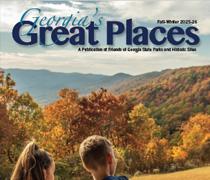Trillium Trail
This 1.25-mile loop traverses four natural communities. Starting along Lake Kolomoki, you will cross several spring-fed streams, climb a moist slope forest, ramble through an upland hardwood forest, and descend a dramatic steephead. Watch for transitions between communities as the trail climbs and descends. These communities appear much as they did when Native Americans grew their crops along the floodplain of Little Kolomoki Creek, now flooded by the lake. As you walk, try to imagine how you might find food, beverages, medicines, fuel, clothing, dyes, shelter and tools if you lived here hundreds of years ago.
Common birds found in this area include piliated and red-bellied woodpeckers, flickers, yellow warblers, pine warblers, cardinals, nuthatch, chickadee and towhee. Wild turkey and bobwhite quail may be spotted on the ground, while red-shouldered hawk, red-tailed hawk and turkey vultures soar overhead. Look for tracks of bobcat, red fox, deer, opossum and raccoon in the soil.
Hikers will see switchcane (a native bamboo), Southern magnolia (large green leaves), sassafrass (three leaf shapes growing on one plant), sarsparilla vine (used to make beverages), sparkleberry, hickory, muscadine grapes, dwarf palmetto (fan-like leaves), loblolly pine and spruce pine.
A separate brochure further describes plants, animals and geology at 20 numbered stops along the trail.
Spruce Pine Trail
Part of Georgia’s Southern Rivers Birding Trail, this 2.5-mile trail starts at the Lake Yohola dam, crosses a road and leads to Lake Kolomoki. The cypress pond area of this second lake is particularly good for birding. The terrain is somewhat rugged, and hikers can enjoy footbridges and wildlife observation platforms. Common trees include magnolia, dogwood, spruce pine and water oak. Wild azaleas bloom in spring. Frequently spotted wildlife includes turkey, deer, quail, bobcat and armadillo.
White Oak Trail
This 1.5-mile trail circles the mounds and passes through part of the village area, which was arranged in a horseshoe shape around the mounds. These woods provided timber used to build thatched huts for housing. Some of the gullies and ravines have underground springs flowing from them, which provided an abundant water source for the village. These springs flow into Lake Kolomoki, then into the Chattahoochee River 12 miles away, which served as a major trade route. Archaeologist believe the Indians chose this site because of the rich farmland, wild game, fishing and abundant water.
Indian Mounds Tour
Hundreds of years ago, this area—with its surrounding villages, burial mounds and ceremonial plaza—was a center of population and activity in North America. This unblazed trail leads to 7 mounds and a cemetery, which are further explained by markers along the way. The gully’s purpose has been debated since the 1840s. Some believe it was once covered, providing a way to get to the creek during a siege, while others thought it provided dirt for the mounds. The main village was located in the plaza, now an open field in front of Mound A. The tallest mound is 56 feet high and the shortest is around 4 feet high.
Mound A
The Temple Mound, constructed more than 700 years ago, is 56 feet high and measures 325 by 200 feet at the base. Research indicates that it would have taken more than 2 million basket loads, each holding one cubic foot of earth, to build this mound. It is believed this mound served as the area’s religious center.
Mound B
A series of wooden posts were erected in this mound, possibly for games.
Mound C
Archaeologists are unsure of Mound C’s function, but it may have been made of sweepings from the plaza. The mound is approximately the same size as Mound B, and is located at the north end of the Temple Mound (corresponding to that of Mound B to the South).
Mound D
During the 1950s, this was excavated and rebuilt to its original size of 20 feet high and nearly 100 feet in diameter. D is one of the largest and most elaborately constructed burial mounds in the Southeastern United States. The mound was built to bury a leader along with sacrificed servants, trophy skulls, and wives. The remains of additional people, whose bodies had been stored in the temple awaiting burial, were included in the mound. Radiocarbon dating estimates the mound was built around 30 A.D.
Mound E
This burial mound of the Weeden Island Tribe was the first of the Kolomoki area to be scientifically excavated. Today, the park’s museum is built into the mound, shown just as archaeologists left it. Four people were buried in this mound, along with 54 pottery items to be used in the afterlife. Radiocarbon dating in 1956 put the building around 170 B.C. The accuracy of radiocarbon dating is within 300 years.
Mound F
This mound is 60 feet long, 50 feet wide and six feet high, with an oval shape. Inside is a square, white clay platform 30 feet wide. Artifacts consist solely of a handful of sherds, most from the Weeden Island period.
Mound G
Burials of the Mercier family, owners of the Mercier Plantation that once included this land, are found here.
Mound H
Archaeologist Dr. William H. Sears speculated this small mound was used in the burial ceremony for the Mound D leader, then capped with red clay. An internal yellow clay platform, measuring three feet high, has not been disturbed.
Other Information
For any questions, visit the Visitor Center or call us at 229.724.2150.















